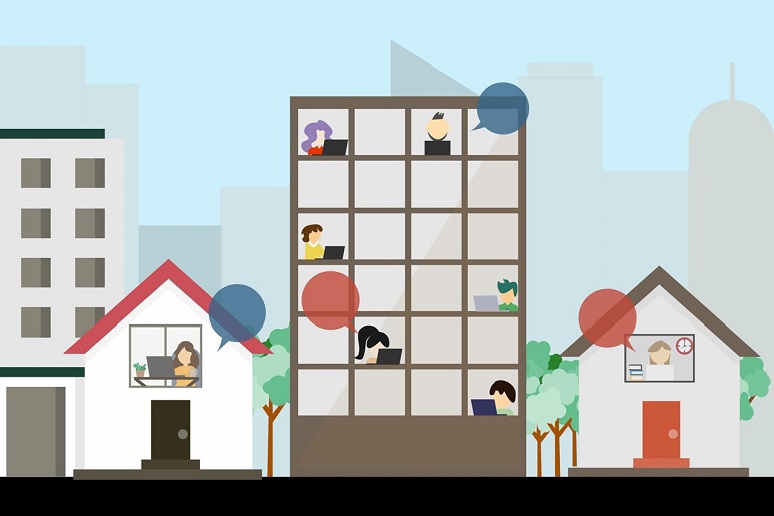The day after I started a remote work position in mid-November with analyst firm Omdia, I ran across an intriguing article in the
New York Times, “
The Worst of Both Worlds: Zooming from the Office.” Reporter
Emma Goldberg details some of the challenges people and organizations are having navigating the variable work experience we call “hybrid work.” She refers to the experience as a “mushy middle ground” and the center of this middle ground is the video meeting, a place Goldberg characterizes as “where remote workers have trouble hearing, a sense that people at home are missing out on perks (teammates), while those in the office are, too (pajamas).”
This mushy middle ground cultivates a kind of bi-directional sense of missing out… an awareness that people on the call may be experiencing some type of loss.
This article resonates strongly with me because I have been a remote worker for years and years, yet I have consulted for most of my career with organizations who have large contingents of office-based employees. I have experienced first-hand video meetings where people sitting in the conference room begin to talk over one another and have side conversations, both of which make it challenging for remote employees to listen in and participate. Sometimes the images of those in the conference room are the size of a postage stamp and the audio isn’t always the greatest—making the remote attendees squint to see who is speaking and strain to concentrate on the flow of the conversation—while simultaneously attempting to capture some semblance of the meaning of what’s being said. It’s all the worst parts of being in a meeting, with none of the perks.
Working remotely provides a great deal of freedom, but there are times when being in the same physical location with others is satisfying, creatively stimulating, and emotionally fulfilling. This is one reason why events like Enterprise Connect have been so important to me over the years – it’s an in-person opportunity to interact with other people, press the flesh so to speak, and meet people. Even for the remote worker, these experiences are often necessary and extremely gratifying. Despite all the great sessions, all the wonderful exhibits, and all the excellent entertainment, I have often said that the most important thing that happens at Enterprise Connect is the in-person networking.
While the omicron variant of the COVID-19 virus will continue to cause organizations to be
cautious about return-to-office plans, our lives and our industry are about to be impacted by some funny things happening in this new metaverse we all live in. Technology is helping navigate that mushy middle ground.
Some companies are beginning to invoke the “One Zoom, All Zoom” rule, which is a meeting metaphor for “if one person joins the meeting remotely, everyone must join using remote meeting technology too, even if some people are in the office.” In theory, this puts everyone on an equal footing for viewing, hearing, and participating in the meeting. As an aside, “muzzling” is also becoming a common tactic of our new all-remote-way-of-working: if the host doesn’t like what someone else is saying, they can just muzzle the offender via the all-powerful mute button. This would have been impossible if everyone were in the same conference room.
Aligned with the “One Zoom, All Zoom” approach is another tactic that some companies are taking: removing the audiovisual equipment from the conference room. This requires everyone to use the same video meeting solution, and it puts everyone on equal footing in the meeting.
Another strategy some companies are doing is to refresh the conference room with newer video (and audio) technology using 4k cameras that enable “intelligent framing,” i.e., using artificial intelligence to identify individual faces in the room and direct the camera to zoom in on the current speaker, giving the remote participants a good visual of the person speaking. Of course, even with intelligent framing, good mics in the conference room are critical, or the remote participant experience will still be a #fail.
One of the funny things coming out of our current remote working experience is seeing how and where companies identify their headquarters location.
David Klein, the CEO of
CommonBond said “
our center of gravity is in the Zoom-isphere.”
Zillow, the real estate listing company, said that it has moved its headquarters from Seattle to the cloud, suggesting that companies that move their headquarters to the cloud will gain post-pandemic competitive advantage. I’ve never really thought of a company being headquartered in the cloud!
Perhaps the emerging
fourth industrial revolution, coupled with
endemic COVID, will create a condition where physical headquarters are no longer needed and where we will work in this sort of existential
metaverse where we can all be virtual, remote, and productive; however, there is significant debate on this topic. A recent statement by WeWork CEO
Sandeep Mathrani implied that the least engaged employees want to work at home. This statement has received significant backlash, however, including from
Forbes Magazine with an article that indicated there are five primary causes of disengagement in the workforce, all management related and location independent:
- Do employees feel supported?
- Do employees feel challenged?
- Do employees feel motivated?
- Do employees feel accepted?
- Are employees fairly compensated?
The Forbes article concluded by stating, “Though being forced to work in a location where one is not comfortable could lead to signs of disengagement, employees’ work location preferences are a poor indicator of their engagement levels. Over the past year, the pandemic taught us many things, one of the most important being that employees can be productive from anywhere.”
It is too early to tell if a hybrid workforce is going to be sustainable long-term for the majority of knowledge worders and their companies – after all, water cooler conversations sometimes do yield tremendous benefit, including social benefits, in the near term, organizations need to how they address how they manage hybrid workers and try to make work as fulfilling, engaging and productive as possible. Part of the effort to avoid a “mushy middle ground” will be achieved by proactively deploying appropriate meeting technology to ensure great meeting experiences where remote and in-office employees can interact and collaborate with one another equitably, comfortably, and creatively.










